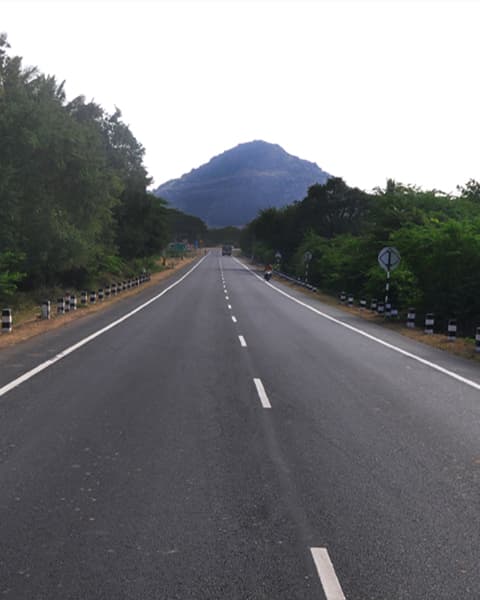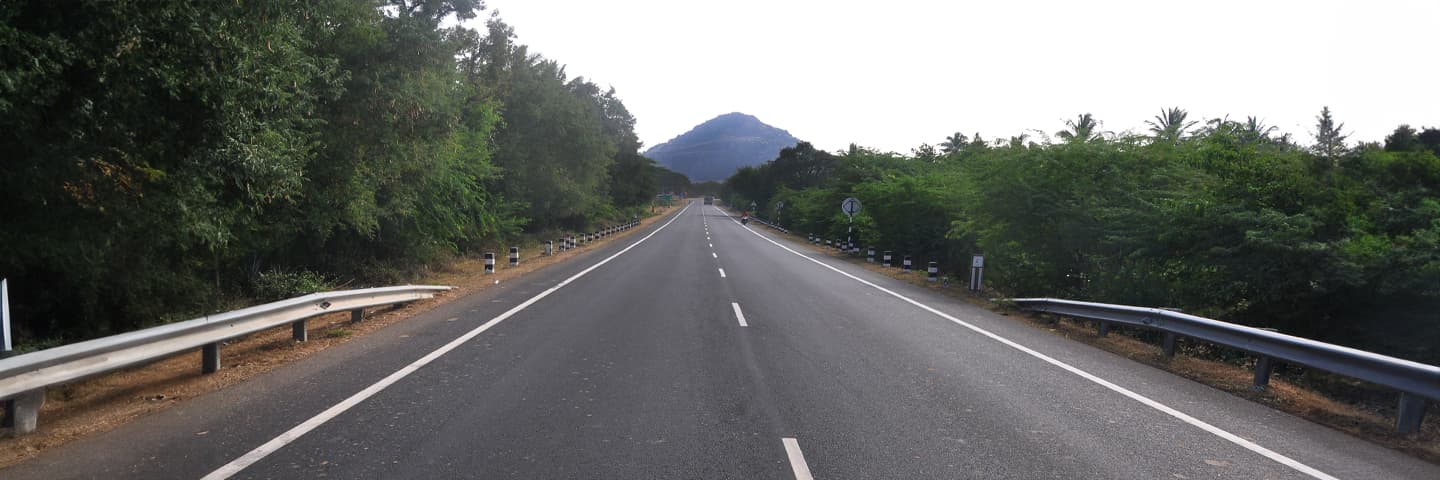Number of Lanes
2
Distance
193.35 Km
Original Concession Period
10 Years

The road improvement project consists of two main components: "Upgradation" and "Rehabilitation." The "Upgradation" aspect focuses on upgrading single and intermediate-lane roads to 12-meter, 2-lane roadways, with improvements in alignment, new pavements, and the addition of features like bridges, culverts, and road safety measures. On the other hand, "Rehabilitation" aims to enhance roads to 5.5-meter carriageways and 8.5-meter roadways, with a primary focus on pavement work. Both categories include improvements to bridges, culverts, safety measures, and urban amenities as needed.
The project road, which is part of SH-33 and SH-3, stretches from Malavalli to Pavagada, with an additional length of 0.976 kilometres from NH-209 to Malavalli. The road traverses through plain and mildly rolling terrain, passing through several urban and semi-urban areas, as well as numerous villages and settlements. Notable urban and semi-urban areas along the route include Maddur, Huliyurdurga, Kunigal, Tumkur, Koratagere, and Madhugiri.
The project's scope involves the reconstruction to a two-lane standard, with the design, build, finance, operate, maintain, and transfer (DBFOMT- Annuity) of the existing State Highway (SH-33 and SH-3) from Malavalli to Pavagada (referred to as the "Project Highway"). The designated length of this project is approximately 193.344 kilometres in the state of Karnataka, excluding the section through AP (13.76 kilometres) and including an additional length of 0.976 kilometres from NH-209 to Malavalli. The project's duration spans ten years, commencing from the appointed date, which includes a construction period of 911 days. It was awarded by the KSHIP Authorities of Karnataka, India, on 12th December 2014.
The Malavalli to Pavagada State Highway serves as a crucial transportation route in Karnataka, playing a vital role in connecting the western regions of the state to key ports on the Eastern Ghats and major cities like Bangalore. This highway supports 70% of commercial and 30% of passenger traffic in the region, facilitating the efficient movement of goods and people. It significantly contributes to the local economy and regional connectivity, ensuring the smooth transportation and trade flow between various regions in Karnataka and beyond.
Benefits of the Project Road
Enhanced Connectivity: The project road, stretching from Malavalli to Pavagada, greatly enhances connectivity between these two crucial locations in Karnataka. This improved link facilitates the seamless movement of people, goods, and services, which, in turn, significantly contributes to regional development.
Improved Safety: The safety aspect of the project is a top priority, with the incorporation of advanced safety features such as upgraded signage, improved lighting, and well-designed intersections. These measures have resulted in a notable reduction in accidents and an overall enhancement of road safety. Moreover, the alleviation of traffic congestion on existing routes, particularly State Highways SH-03 and SH-33, contributes to smoother traffic flow and a reduced burden on these highways, further enhancing safety.
Reduced Travel Times: he newly constructed road project promises to significantly reduce travel times for both commuters and the transportation of goods between Malavalli and Pavagada. This is of paramount importance for businesses and commerce, as it ensures quicker and more efficient movement of goods and services. Simultaneously, the effective management of traffic volume on the existing highways is achieved through the project road, leading to improved traffic distribution and reduced congestion, thus optimizing the entire transportation network.
Economic Growth: The agricultural sector, a key contributor to the regional economy, stands to benefit from the upgraded road network as it enables the efficient transportation of agricultural produce to markets. This reduction in spoilage and increased farmers' incomes further fuel the economic growth in the area. Additionally, improved access to scenic and recreational spots boosts tourism and the local tourism industry. Furthermore, the project road acts as a catalyst for the development of towns and villages along the route, bringing enhanced accessibility that leads to improved infrastructure and services. This development includes better healthcare, education, and market facilities. Lastly, by serving as part of vital trade routes, the road benefits businesses by providing efficient connections to markets and ports, ultimately stimulating economic growth.
Impact on Road Users
Commuters: Road users, particularly commuters, will experience a significant improvement in their travel experience with the completion of this project. Reduced travel times and enhanced convenience will result in a smoother and more efficient commute. The project's focus on reducing congestion on existing routes is a major advantage, making daily commuting less stressful and time-consuming. Safety enhancements, such as proper signage, improved lighting, and well-designed intersections, ensure a safer journey for all.
Truck Drivers: The reduction in travel times not only means shorter trips but also translates to lower operating costs due to reduced fuel consumption. The reduced congestion on existing routes will also boost the efficiency of the logistics industry, allowing for smoother transportation of goods. Additionally, safety features such as improved signage and well-designed intersections ensure that truck drivers can operate with greater security and peace of mind.
Tourists: The better access to scenic and recreational areas, promotes tourism and leisure travel. Reduced travel times, along with well-constructed roads that prioritize safety, offer tourists a more enjoyable and convenient journey. This improved access contributes to the growth of the local tourism industry, as tourists can explore new destinations with ease, adding to the region's appeal and economic development. Additionally, the enhanced road infrastructure facilitates quicker access to emergency services, improving safety and security for all travellers.
Impact on Communities
Economic Development: The improved road connectivity can stimulate economic growth in local communities by promoting trade, attracting businesses, and creating job opportunities. This can lead to an overall increase in the standard of living.
Employment Opportunities: Farming communities will benefit from better transportation options, enabling easier access to markets and reducing the spoilage of agricultural produce. This can enhance the income of farmers and boost the agricultural sector.
Accessibility to Services: Improved road infrastructure can lead to better access to essential services, such as healthcare, education, and markets, for communities residing along the route.
Accolades
The project has been certified under six ISO certification categories:
- ISO 9001:2015 Quality Management System
- ISO 14001:2015 Environmental Management System
- ISO 39001:2012 Road Traffic Safety Management System
- ISO 45001:2018 Occupational Health and Safety Management System
- ISO 31000:2018 Risk Management
- ISO 27001:2022 Information Security and Management System
Mysore - Bellary Highway Private Limited (MBHPL)
CIN: U45203TN2014PTC165197
*Note: The concession period has concluded and MBHPL is in the process of handing over the project to the concessioning authority in accordance with the concession agreement. Upon issuance of vesting certificate by the aforesaid authority in the near future, the handover will stand completed.

